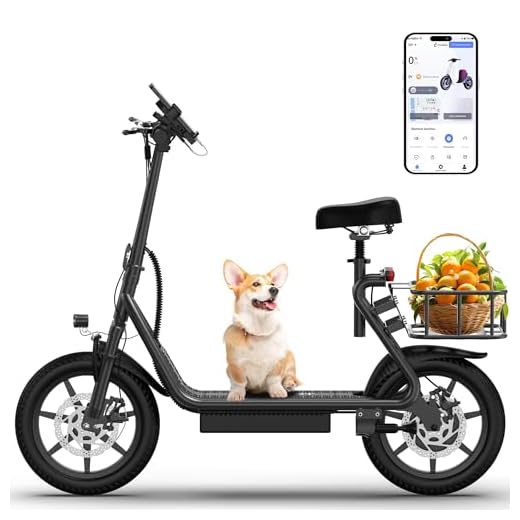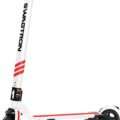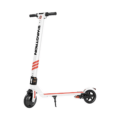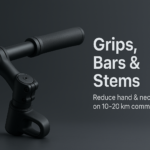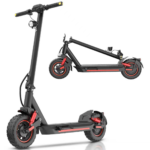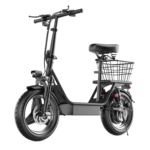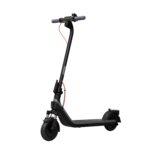- Home
- Scooters
- Compare Scooters
- DXH X8 PRO vs MAXSHOT X1: Which One is Right for You?
DXH X8 PRO vs MAXSHOT X1: Which One is Right for You?
If you’re shopping in the budget-to-mid electric scooter tier, two names keep popping up: DXH X8 PRO and MAXSHOT X1. On paper they look similar—both promise roughly 19–22 mph, commuter-friendly ranges, and app control. In practice, they aim at very different riders. One is a classic stand-up scooter with 10″ tires that’s easy to carry and stash. The other is a utility-minded sit/stand rig with big 14″ wheels, dual disc brakes, suspension, and a rear cargo basket vibe. This guide breaks it all down—specs, comfort, safety, portability, and who should buy which—so you can stop doom-scrolling and start riding.
Specs at a glance (what really matters)
DXH X8 PRO
- Motor: 500W (class)
- Top speed: up to ~19 mph
- Range: up to ~24 miles (best case)
- Tires: 10″ solid (no flats)
- Brakes: rear disc + electronic (regen/E-ABS)
- Max load: ~220 lb
- App control: yes
- Fold: single-stem, compact
MAXSHOT X1
- Motor: 500W hub motor (often marketed with higher peak)
- Top speed: up to ~22 mph
- Range: up to ~27 miles (best case)
- Tires: 14″
- Suspension: yes (front/rear on most packages)
- Brakes: dual disc
- Seat & rear basket: common/included on many listings
- Max load: ~265 lb
- Footprint: bulkier than a typical stand-up due to seat and rack
A quick reality check on claims: brands quote “ideal” numbers—light rider, flat ground, eco mode, mild temps. In mixed real-world use, expect roughly 60–70% of the claimed range. That’s normal across this category.
How they feel to ride
Stability & comfort
- DXH X8 PRO: The 10″ solid tires are low-maintenance (no tubes, no flats), but they transmit bumps more than pneumatic tires would. For short city hops, it’s totally fine. For rougher pavement or longer rides, you’ll feel more road texture through your feet and wrists. The compact deck and familiar geometry make it quick and nimble in traffic and on bike paths.
- MAXSHOT X1: The 14″ wheels are the star—bigger diameter means potholes, cracks, and curb lips are less dramatic. Add a seat, suspension, and dual disc brakes and it starts to feel more like a mini-moped than a basic scooter. If comfort matters (knees/back/wrists), the X1’s sit-friendly layout and calmer handling reduce fatigue on longer rides.
Power & hills
Both live in the 500W class. On flat ground, that’s plenty for their advertised speeds. On hills, 500W will chug up moderate grades; steeper climbs or heavier riders will slow either model. The X1 is often pitched with a higher peak output, which can translate into a little more starting torque and hill recovery—handy if you’re carrying a backpack or groceries in that rear basket.
Braking confidence
- X8 PRO: Rear mechanical disc + electronic regen is a common, effective combo in this price range. It’s simple, keeps weight down, and provides predictable stopping as long as you keep the rotor and pads in good shape.
- X1: Dual disc brakes plus suspension equals stronger bite and more stability under hard braking, especially with the extra mass of a seat kit and cargo. If you do mixed traffic or downhill segments, that extra braking headroom is comforting.
Portability & storage
- DXH X8 PRO: This is where the X8 shines. Without a seat or rack, it folds into a tidy, single-stem package you can carry up a couple flights, stash under a desk, or tuck into a closet. If you ride the train/bus or live in a walk-up, portability alone can be the deciding factor. Some X8-style scooters use removable batteries, which is great for charging at your desk—check the exact configuration you’re buying.
- MAXSHOT X1: It folds, sure, but the seat and basket make it bulkier and a bit awkward to lug. Think hallway parking, garage corner, or elevator life—not shoulder-carry. If you have space and don’t plan to haul it regularly, the bigger footprint won’t matter. If daily stairs are in your future, think hard before choosing the seated format.
Range & speed in the real world
- DXH X8 PRO: Claimed up to ~24 miles and ~19 mph. In everyday use (stop-and-go, varied surfaces, normal temps), many riders see mid-teens to high-teens for range. That’s plenty for short commutes, errands, and campus rides. Solid tires mean fewer headaches, but comfort is a bit firmer.
- MAXSHOT X1: Claimed up to ~27 miles and ~22 mph. Because the X1 is more comfortable, you’re more likely to actually ride it across its available range without feeling rattled. Expect something like 16–20 miles for most adults in mixed conditions. If range is critical, look at higher-capacity “Pro” variants.
Safety, control, and day-to-day usability
- Lighting & visibility: Both typically ship with a headlight and taillight. The X1’s larger stance and dual discs inspire more confidence for dusk/dawn commuting, especially when you’re carrying weight. Some versions may add turn signals; check the exact trim before buying.
- Apps & locking: Each supports basic app control—speed settings, cruise, maybe an electronic lock. Handy, but not a substitute for a physical lock if you’re leaving it outside a café.
- Rider weight: The X8 PRO generally sits around ~220 lb max, while the X1 tends to claim ~265 lb. If you’re close to those limits, leave margin for a backpack, water, or groceries. Higher loads affect braking distance and hill speed more than you’d think.
- Maintenance: Solid tires on the X8 PRO reduce puncture stress. The X1’s larger wheels and suspension mean more parts to keep an eye on but reward you with comfort. Brakes on either model should be adjusted periodically; dual discs on the X1 equal twice the pads to check.
Who should buy the DXH X8 PRO?
Choose the X8 PRO if you want a simple, low-maintenance stand-up scooter for short, predictable commutes:
- You value portability—stairs, public transit, or tight storage are part of your life.
- No-flat solid tires sound great (even if the ride is a bit firmer).
- Your route is mostly flat to mildly hilly, with trips under ~8–10 miles round-trip.
- You prefer a classic scooter feel—no seat, no basket, minimal bulk.
Why it fits: the X8 PRO keeps weight and volume down, offers reasonable speed, and avoids fuss. The rear disc + regen braking layout is proven, and app control covers basics like modes and locking. For students, apartment dwellers, and last-mile commuters, it’s the practical pick.
Who should buy the MAXSHOT X1?
Pick the X1 if you want a comfort-first, utility-ready scooter that can double as a mini errand-runner:
- You want a seat for longer rides (or your knees/back simply prefer sitting).
- You’ll carry cargo—groceries, a backpack, maybe a small delivery bag—so the basket and dual disc brakes matter.
- Your roads are patchy and you’d benefit from 14″ wheels and suspension.
- You’re heavier or ride rolling grades and appreciate a bit more torque/peak power.
Why it fits: the X1 rides calmer, stops stronger, and feels planted, especially with weight on board. If you’re replacing short car trips or need a campus/urban hauler that doesn’t beat you up, the X1’s format makes daily use less of a chore.
A few buying checkpoints before you click “Buy”
- Local rules: Some cities cap e-scooter speeds or restrict where you can ride. Know your local regulations; they affect both safety and potential fines.
- Range math: If your round trip is over ~12–15 miles, plan to charge at work or upgrade to a higher-capacity battery. Claimed ranges are optimistic by design.
- Hills & rider weight: Any 500W scooter will slow on steeper grades. If you have sustained hills or you’re near the upper weight limit, either adjust expectations or consider a higher-power class.
- Tires: Solid = no flats but firmer feel; larger wheels = more stability and comfort. Decide if you’d rather deal with occasional tube maintenance (not an issue here for the X8) or a slightly harsher ride.
- Brakes: If you’ll ride in traffic or carry cargo frequently, dual discs (X1) provide extra stopping headroom and better modulation. If you’re mostly on paths and neighborhood streets, the X8’s setup is adequate.
- Storage & carrying: Be honest about your lifestyle. Stairs every day? Tight hallways? The X8’s compact fold will save your shoulders. Roomy garage and elevator? The X1’s size becomes a non-issue.
The bottom line (and a quick decision tree)
- Get the DXH X8 PRO if you want the light, classic stand-up experience with no-flat 10″ tires, a tidy fold, and commuter-friendly speed. It’s built for portability, simplicity, and low maintenance.
- Get the MAXSHOT X1 if you want a mini-moped vibe with 14″ wheels, a seat, dual discs, and better rough-road manners—basically, a scooter you’ll actually choose for longer rides and small errands because it’s more comfortable and stable.
Still undecided? Ask yourself two questions:
- Will I carry stuff or ride for more than ~30–40 minutes at a time?
If yes, X1. If no, X8 PRO is likely plenty. - Do I need to carry the scooter up stairs or stash it under a desk?
If yes, X8 PRO. If no, X1’s size won’t bug you—and its comfort is worth it.
Final verdict
Think of these two models less as competitors and more as two answers to different problems. The DXH X8 PRO solves for portability, simplicity, and “grab-and-go” commuting where storage and stairs are the bottlenecks. The MAXSHOT X1 solves for comfort, confidence, and utility, turning quick errands and longer rides into something you want to do, not something you merely tolerate. Match the scooter to your routes, your storage reality, and your body’s preferences, and you’ll be happy with your choice—no regrets, just more miles.
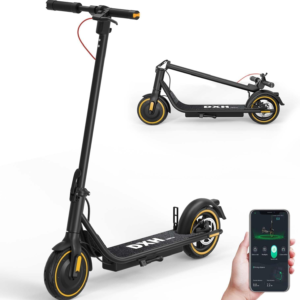 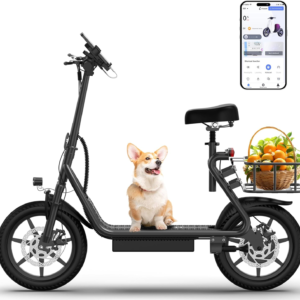 | |
| Price | |
| Our Rating | |
| Brand | DXHMAXSHOT |
| Category | Electric ScootersElectric Scooters |
General
| Model The Model specifies the exact version or name of the scooter. It helps identify its unique design, features, and specifications within the manufacturer’s product line. Knowing the model makes it easier to compare options, find compatible accessories, or look up support information. | X8 PROX1 |
| Brand The Brand identifies the manufacturer or company that designs and produces the scooter. A trusted brand is a sign of quality, reliability, and good customer support. Well-known brands often have higher standards for safety, performance, and after-sales service, giving you more confidence in your purchase. | DXHMAXSHOT |
| Release Date The Release Date indicates when the scooter model was officially launched on the market. This helps you know how current the design, technology, and features are. A newer release date often means updated components, improved performance, and the latest safety or smart features. | 01 May 202501 January 2025 |
| Recommended Age Recommended Age indicates the minimum age range that the scooter is designed for, based on safety, size, and ease of use. Following the recommended age helps ensure that riders can handle the scooter’s speed, weight, and controls comfortably and safely. Always check local laws and use protective gear, especially for younger riders. | 16+14+ |
Performance & Power
| Motor Power (Wattage) What it means: The motor power, measured in watts (W), shows how strong the scooter’s electric motor is. Why it matters: Higher wattage usually means better acceleration, more torque, and improved performance on hills or rough terrain. For example, a 250W motor is good for flat city roads and light riders, while a 500W or 1000W motor provides more power for faster speeds or climbing steep inclines. | 500W500 W brushless hub motor |
| Top Speed The Top Speed indicates the maximum speed that the scooter can reach under optimal conditions. It’s usually measured on level ground with a fully charged battery and an average rider weight. A higher top speed allows you to travel longer distances faster, but always ensure you ride within legal speed limits and your personal comfort zone for safety. | 35 km/h (21 mph)22 mph (35 km/h) |
| Battery Capacity Battery Capacity refers to the total amount of energy the scooter’s battery can store, usually measured in ampere-hours (Ah) or watt-hours (Wh). A higher battery capacity means you can ride longer distances on a single charge, reducing the need for frequent recharging. Keep in mind that actual range can vary depending on rider weight, terrain, speed, and weather conditions. | 13Ah, 36V36V, 10.5Ah (378Wh) |
| Estimated Range per Charge The Estimated Range per Charge indicates the average distance the scooter can travel on a single full battery charge. This range is calculated under optimal conditions, such as flat terrain, moderate speed, and average rider weight. Real-world range may vary depending on riding style, terrain, weather, and load. A longer range means fewer recharges and greater freedom for longer trips. | up to 40 km (25 miles)27 miles (43 km) |
| Hill Climb Ability Hill Climb Ability describes the maximum incline or slope that the scooter can handle while maintaining stable performance. It’s typically expressed as a percentage or in degrees. A higher hill climb rating means the scooter can tackle steeper hills without losing too much speed or power. Actual climbing performance may vary based on rider weight, battery charge, and terrain conditions. | up to 15% incline20% incline |
| Drive System The Drive System refers to how power from the motor is delivered to the wheels. Electric scooters typically use either a hub motor (directly integrated into the wheel) or a chain/belt drive system. A high-quality drive system ensures smooth acceleration, efficient power transfer, and low maintenance. The choice of drive system affects performance, noise level, and overall ride experience. | Rear motorRear-wheel hub motor |
Charging & Electrical
| Charging Time Charging Time indicates how long it takes to fully recharge the scooter’s battery from empty to 100% using the standard charger provided. Faster charging means less downtime and more time on the road. Actual charging time may vary slightly depending on battery capacity, charger output, and environmental conditions. | 5-6 hoursApprox. 4 hours |
| Battery Type Battery Type refers to the specific technology used in the scooter’s battery, which affects performance, lifespan, weight, and charging time. Most modern electric scooters use high-quality lithium-ion (Li-ion) batteries because they offer a good balance of energy density, durability, and low maintenance. A reliable battery type ensures consistent power delivery and longer riding ranges. | Lithium-ionLithium-ion |
| Removable Battery A Removable Battery means the battery pack can be easily detached from the scooter for convenient charging and replacement. This feature allows you to charge the battery separately, swap it with a spare for extended range, or securely store it indoors in extreme weather. Removable batteries add flexibility and make it easier to keep your scooter powered up wherever you are. | YesNo |
| Regenerative Braking Regenerative Braking is an energy-saving feature that converts some of the energy normally lost during braking back into battery power. When you slow down or brake, the motor works in reverse to generate electricity, which helps extend the scooter’s range and improves overall efficiency. This system also reduces wear on traditional brake components, leading to lower maintenance over time. | YesYes |
| Lighting Lighting refers to the built-in front and rear lights that enhance visibility and safety when riding in low-light conditions or at night. Good lighting helps you see the road ahead and ensures that other road users can see you. Many scooters include LED headlights, taillights, and sometimes brake lights or side reflectors for added safety and compliance with local traffic regulations. | Front LED headlight, rear brake light, side reflectorsLED Headlight, Rear Brake Light, and Side Reflectors |
Build & Dimensions
| Scooter Weight Scooter Weight refers to the total weight of the scooter when fully assembled, including the battery. This affects how easy it is to carry, lift, and store the scooter when not in use. A lighter scooter is more portable and convenient for commuting, especially if you need to carry it upstairs or onto public transport. Keep in mind that a sturdy frame and quality components may add to the weight but also contribute to better durability and ride stability. | 15 kg (33 lbs)39 lbs (17.7 kg) |
| Maximum Rider Weight Maximum Rider Weight indicates the highest rider weight that the scooter is designed to safely support while maintaining optimal performance and stability. Staying within this limit helps ensure reliable acceleration, braking, and climbing ability, and it protects the frame, suspension, and motor from excessive strain. Exceeding the recommended limit may reduce performance and increase wear on components. | 120 kg (265 lbs)265 lbs (120 kg) |
| Deck Size Deck Size refers to the dimensions of the scooter’s standing platform. A wider and longer deck provides more foot space, allowing you to stand comfortably and adjust your stance while riding. A well-sized deck improves balance and stability, especially on longer rides or at higher speeds. Compact decks, on the other hand, help keep the scooter lightweight and portable. | 46 cm × 15 cm (18 × 6 inches)Spacious anti-slip deck (not numerically specified) |
| Handlebar Height Handlebar Height refers to the distance from the deck to the handlebars, which affects your riding posture and comfort. An appropriate handlebar height helps you maintain good balance, reduces strain on your back and arms, and makes steering more comfortable. Some scooters have adjustable handlebars to fit riders of different heights, while others have a fixed height for a streamlined design. | Adjustable, 90–120 cm (35–47 inches)40.7 inches (fixed) |
| Folding Mechanism The Folding Mechanism describes how easily and securely the scooter can be folded for carrying and storage. A well-designed folding system lets you quickly collapse the scooter into a compact size, making it convenient to transport on public transit, store under a desk, or fit into a car trunk. Look for sturdy latches and safety locks to ensure the scooter stays firmly in place when folded or unfolded. | YesYes |
| Dimensions Folded Dimensions indicate the size of the scooter when it’s fully folded. This measurement shows how much space the scooter will take up when stored or carried, making it easier to check if it will fit in your car trunk, under a desk, or in a closet. Compact folded dimensions are ideal for commuters who need to bring their scooter on public transport or store it in tight spaces. | 110 × 20 × 40 cm (43 × 8 × 16 inches)47” L × 20.7” W × 40.7” H |
| Material Material refers to the primary construction materials used for the scooter’s frame and key components. High-quality materials like aircraft-grade aluminum, reinforced steel, or durable composites provide strength, stability, and a lighter overall weight. A sturdy material ensures the scooter can handle daily wear and tear while maintaining safety and performance. | Aircraft-grade aluminium alloyAluminum frame |
Safety & Control
| Brake Type(s) Brake Type(s) describe the braking systems the scooter uses to help you slow down or stop safely. Common brake types include mechanical brakes (like drum or disc brakes), electronic brakes, and foot brakes. Many scooters combine multiple braking systems for added safety and shorter stopping distances. The type and quality of brakes affect your control, especially when riding at higher speeds or on slopes. | Rear disc brake + regenerative electronic brakeDual disc brakes (front and rear) |
| Suspension Suspension refers to the system that absorbs shocks and vibrations while riding, providing a smoother and more comfortable ride over uneven or rough surfaces. Scooters may have front suspension, rear suspension, or dual suspension for better shock absorption and stability. Good suspension helps reduce rider fatigue and improves control, especially when riding on bumpy roads or off-road paths. | Front and rear dual suspensionDual front spring suspension |
| Tire Type Tire Type refers to the kind of tires the scooter uses, which directly affects ride comfort, traction, and maintenance. Common types include solid (airless) tires, pneumatic (air-filled) tires, or hybrid options. Pneumatic tires offer better shock absorption and a smoother ride on rough surfaces, while solid tires are puncture-proof and require less upkeep. The right tire type helps ensure safe handling and a comfortable ride in different conditions. | Pneumatic tiresPneumatic rubber tires |
| Tire Size Tire Size indicates the diameter and width of the scooter’s tires, which affect ride comfort, stability, and how well the scooter handles different terrains. Larger tires generally offer better shock absorption and a smoother ride over bumps and rough surfaces, while smaller tires keep the scooter lighter and more portable. Choosing the right tire size helps ensure a balance between agility and comfort. | 10 inches14 inches |
| Kickstand The Kickstand is a built-in stand that allows you to park your scooter upright when it’s not in use. A sturdy kickstand keeps the scooter stable and prevents it from tipping over, protecting it from scratches and damage. It also makes storing and accessing your scooter more convenient, whether you’re at home, work, or on the go. | YesYes |
| Water Resistance Rating Water Resistance Rating indicates how well the scooter is protected against water and moisture, usually shown as an IP (Ingress Protection) rating. This rating helps you understand whether the scooter can handle light rain, splashes, or wet roads without damage. While most scooters are not fully waterproof, a good water resistance rating adds peace of mind when riding in changing weather conditions. Always avoid deep puddles or submerging the scooter to protect its electrical components. | IP54IP54 |
Features & Extras
| Display/Console The Display (or Console) shows important real-time information about your ride, helping you monitor your scooter’s status at a glance. Typical displays show speed, battery level, distance traveled, and riding mode. Some models also include additional features like Bluetooth connectivity, app integration, or backlighting for better visibility at night. A clear and easy-to-read display enhances safety and convenience on every trip. | LED display (speed, battery, mode, mileage)LED display (speed, battery, mode) |
| Ride Modes Ride Modes refer to the different speed and power settings you can choose to match your riding style or road conditions. Common modes include eco for maximum range and energy efficiency, standard for everyday balance, and sport or turbo for higher speed and stronger acceleration. Switching between ride modes allows you to customize performance, conserve battery, and ride safely in various environments. | Eco, Normal, SportEco, Standard, Sport |
| Smart App Connectivity Smart App Connectivity lets you pair your scooter with a dedicated mobile app via Bluetooth. Using the app, you can monitor real-time ride stats like speed, battery level, and range, adjust settings such as ride modes or cruise control, lock the scooter for added security, and sometimes receive firmware updates. This feature adds convenience and allows you to personalize your riding experience right from your smartphone. | YesYes |
| Anti-Theft System The Anti-Theft System helps protect your scooter from unauthorized use or theft. This feature can include built-in alarms, electronic motor locks, GPS tracking, or remote locking through a mobile app. A good anti-theft system provides peace of mind when parking your scooter in public spaces, adding an extra layer of security to safeguard your investment. | Digital lock via appCombination lock included |
| Cruise Control Cruise Control allows you to maintain a steady speed without continuously holding the throttle. This feature makes longer rides more comfortable by reducing hand fatigue and providing a smoother, more relaxed riding experience — especially on flat, open roads or bike lanes. For safety, cruise control can usually be easily activated or deactivated while riding. | YesYes |
| Accessories Included Accessories Included lists the additional items that come with the scooter to enhance your riding experience and convenience. Common accessories may include a charger, kickstand, bell, lights, phone holder, or carrying strap. These extras add value by making your scooter safer, easier to use, and ready to ride straight out of the box. | Bell, charger, user manual, toolkitSeat, rear cushion, phone mount, basket, charger, user manual |
Warranty & Compliance
| Warranty Period The Warranty Period indicates how long the manufacturer guarantees the scooter against defects in materials and workmanship under normal use. A good warranty provides peace of mind, showing the brand’s confidence in its product quality. Always check what parts are covered, such as the frame, battery, and motor, and follow the maintenance guidelines to keep your warranty valid. | 12 months1 Year |
| Certifications Certifications confirm that the scooter meets specific safety, quality, and environmental standards set by recognized organizations or regulatory bodies. Common certifications may include CE, RoHS, UL, or other local compliance marks, depending on your region. These certifications ensure that the scooter is manufactured to high standards and is safe and legal to use in your country. | CE, RoHSUL 2272 certified |
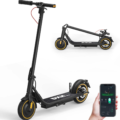 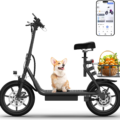 |



